Preserved Lemons
This post may contain affiliate links. See my disclosure policy.
Get ready to unlock one of the grand secrets of Moroccan and Middle Eastern cuisine by learning how to make preserved lemons in this step-by-step tutorial. These homemade preserved lemons are a powerhouse ingredient that will infuse your dishes with such an incredible flavor and absolutely transform any dish you add them to, whether savory or sweet. Just a few minutes of your time will give you this magical ingredient that keeps for months and you can enjoy all the year through!
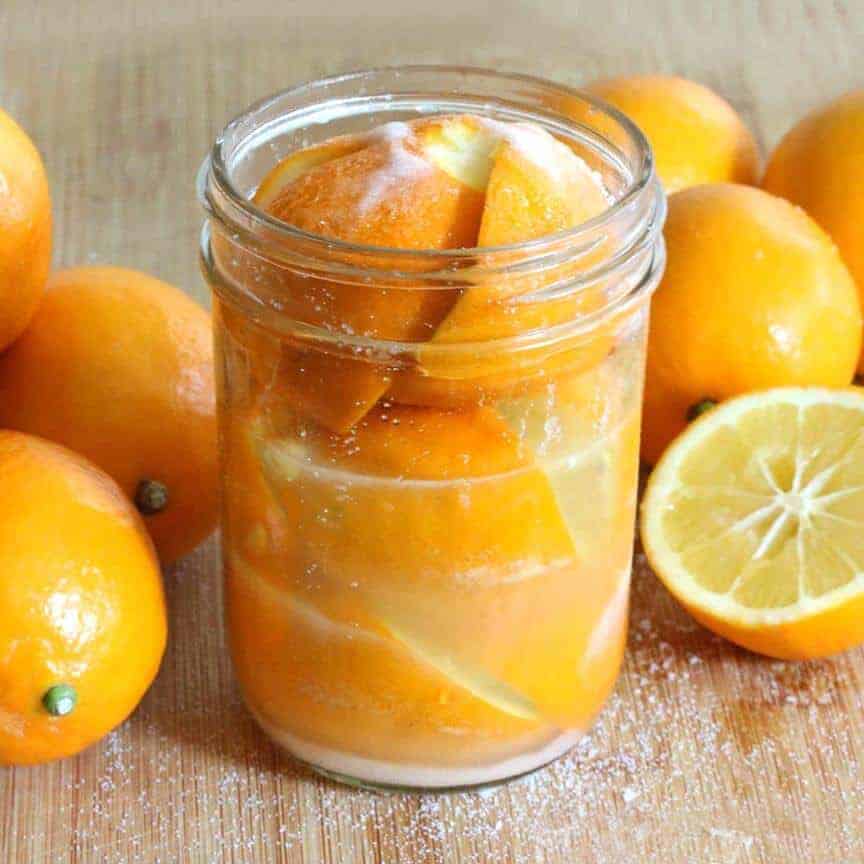
If you’re a fan of Moroccan and Middle Eastern cooking you’ve probably had the experience of thumbing through recipes, drooling all the while, earmarking the ones you particularly like, only to then scan through the ingredients and see the words: “Preserved Lemons”. Your heart sinks for a moment as you realize you are sorely lacking this crucial ingredient. And so with disappointment you un-earmark that page and move on to the next recipe. DON’T let that scenario stop you again. Because nothing could be easier than making your own DIY preserved lemons! These are one of my most favorite “secret” ingredients and I’m going to show you exactly how to make them and how to use them in lots of delicious ways!
What Are Preserved Lemons?
Preserved lemons are lemons that have been packed in salt and their own juices and are left to cure for about a month. During that time the flavors transform in which the acidic tartness disappears and you’re left with a very amplified and complex lemon flavor. Think of preserved lemons as lemons on steroids. They add an intense, concentrated lemon flavor to the dish without all the sour tartness. The preserving process tempers the tartness while accentuating the lemon flavor. In other words, mildly tart but intensely lemony. And if you’re a lover of all things lemon, preserved lemons need a permanent place in your pantry. I can assure you, there is virtually always a jar of these in my fridge!
This preservation process also extends the shelf life of the lemons and they’ll keep for around 6 months in your fridge and even longer if you can them. Over time the lemons become soft and to use them you simply remove however much you need, scrape off the fleshy interior, rinse off the peel, dice it up, and add it to your dishes. Preserved lemons have been around for centuries and are used extensively in Middle Eastern and North African cuisines, most famously Moroccan food. Their unique flavor adds an incredible amount of flavor to a wide variety of savory dishes and desserts.
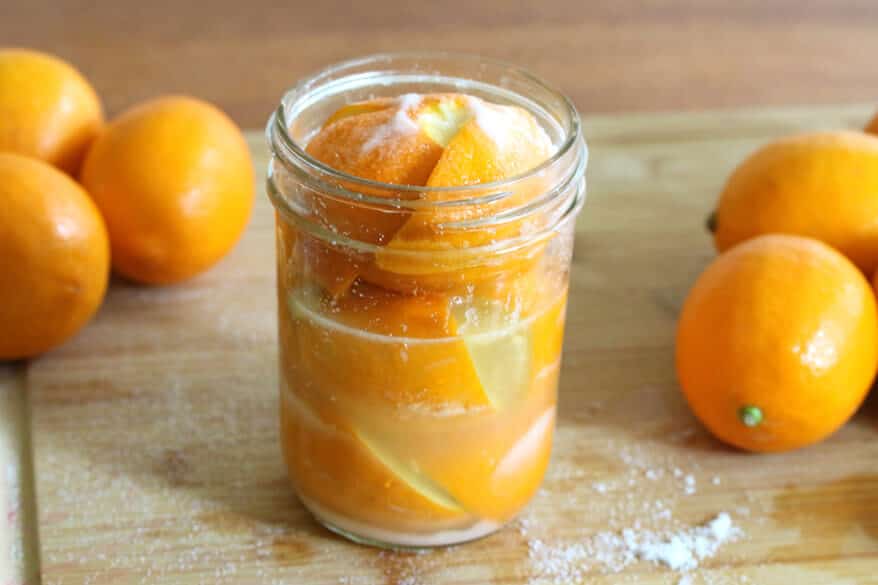
How to Use Preserved Lemons
You’ll find preserved lemons called for in a lot of Middle Eastern and Moroccan recipes, everything from tagines to stews and salads and add a uniquely tangy, salty, and mildly sweet flavor. They can be added to any dish that calls for or can benefit from a touch of lemon flavor. And that includes desserts. Here are just a few ways to use preserved lemons:
- Tagines and stews: a little goes a long way to adding life and flavor. Try them in my Moroccan Harira and Moroccan Chicken Tagine. They’re also great in a variety of bean stews and lentil soups.
- Chicken, duck, beef, lamb, pork, and fish: preserved lemons pair beautifully with any protein. Try them in my Moroccan Chicken (Djej Makalli). And of course lemon and seafood are soulmates. Now just wait until you’ve paired it with preserved lemons and your life is forever changed.
- Salads: Finely mince and toss them into your salads, including pasta salads. They also pair beautifully with grain salads and grain bowls. Try them in two of my personal favorites, this Moroccan Chicken Salad and Curried Couscous Salad.
- Rice, grain, and pasta dishes: try them in my Salmon Risotto – it’s a match made in heaven.
- Marinades: Incorporate them into marinades for chicken, lamb, pork and fish. They add just touch of acidity and a whole depth of flavor.
- Dressings, sauces and dips : Blend them into dressings, vinaigrettes and sauces for an exciting flavor punch. They also work really well in creamy sauces. Add some to your Hummus or Baba Ganoush or to some Greek yogurt along with fresh dill for a refreshing dip.
- Sandwiches and Wraps: you can even add them to your burgers for a fun flavor boost. Oh, and add them to Falafel!
- Salsas and Relishes: chop some up and it to your salsas and relishes for a unique lemony twist like my Mango Salsa and Pineapple Salsa.
- Roasted Vegetables: Toss your roasted veggies with some butter and finely minced preserved lemons for a fabulous flavor. They pair particularly well with root vegetables and cauliflower.
- Cakes, Cupcakes, Muffins, etc: Anything that you would add lemon zest to, try adding some finely minced preserved lemon. Try it in our Preserved Lemon and Ginger Pound Cake.
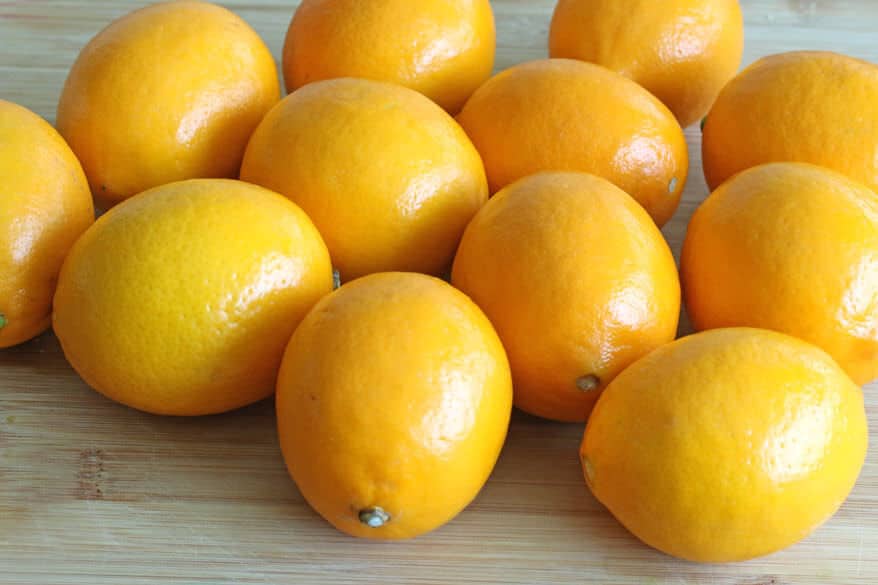
What Kind of Lemons Are Best?
Doqq and boussera lemons are commonly used in Morocco. They have thinner skins and are sweeter than regular lemons. A great substitute is Meyer lemons. If you can’t find Meyer lemons you can use regular lemons such as Eureka or Lisbon. Organic is ideal since it’s the lemon rinds that are eaten.
Variations
Did you know, you can also make preserved limes, oranges, grapefruit and kumquats! The process is identical but because high acidity is required for proper preservation and other citrus varieties have a lower acid content, you will still need to top off the jars with lemon juice. Experiment with these other citrus varieties for some fun flavor variations.
How Long Do Preserved Lemons Last?
Preserved lemons can be stored at room temperature but they’ll ferment very quickly that way and won’t keep as long. It’s recommended to store them in the fridge, in a glass jar with a lid, where they will keep for up to 6 months, and quite possibly longer. Just check periodically for any signs of mold or off colors and smells.
Preserved Lemons Recipe
Let’s get started!
Organic is ideal if you can find them since it’s the rinds that are eaten. If you can’t find organic, let the lemons soak in a vinegar-water solution for a few minutes to clean the outer peels, then rinse.
Trim the nubs off both ends of each lemon.
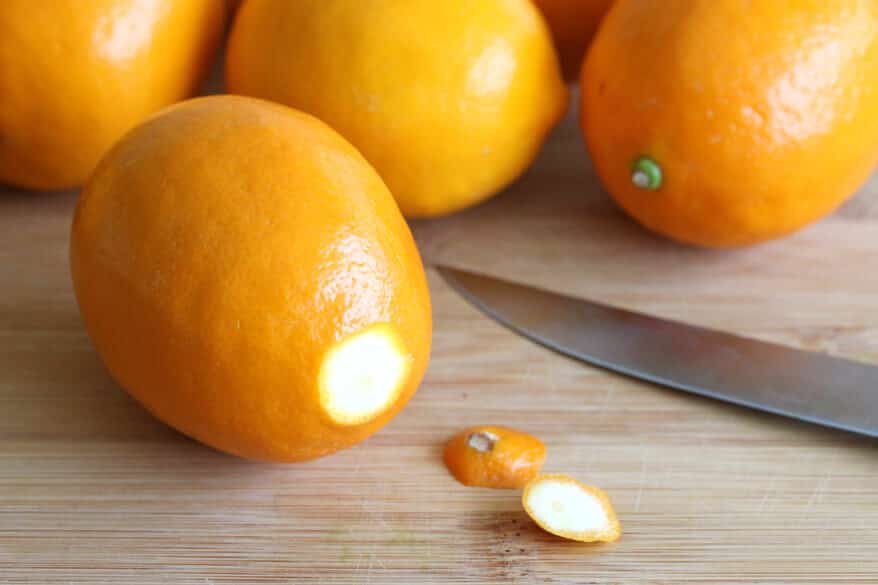
Slice the lemons into quarters, leaving the ends attached. So slice down just a little over 3/4 of the way.
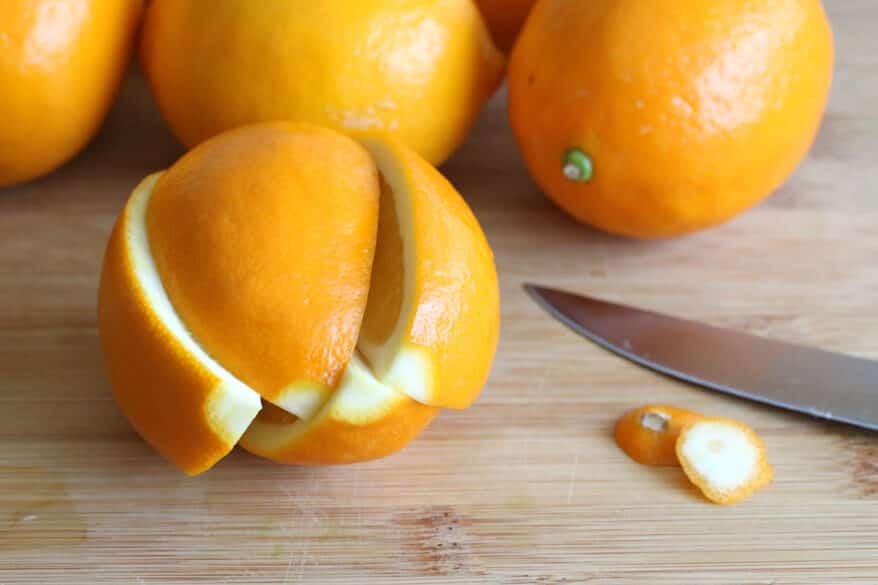
Put a teaspoon of salt in the bottom of a pint-sized jar. Put another teaspoon of salt into the quartered lemon.
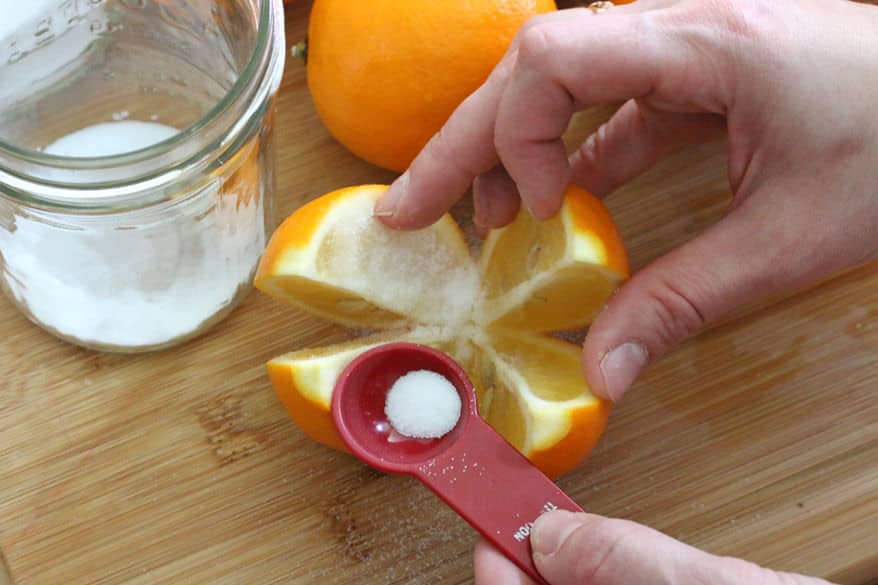
Stuff the lemon into the jar, open end down, and push hard to squish it and release its juices.
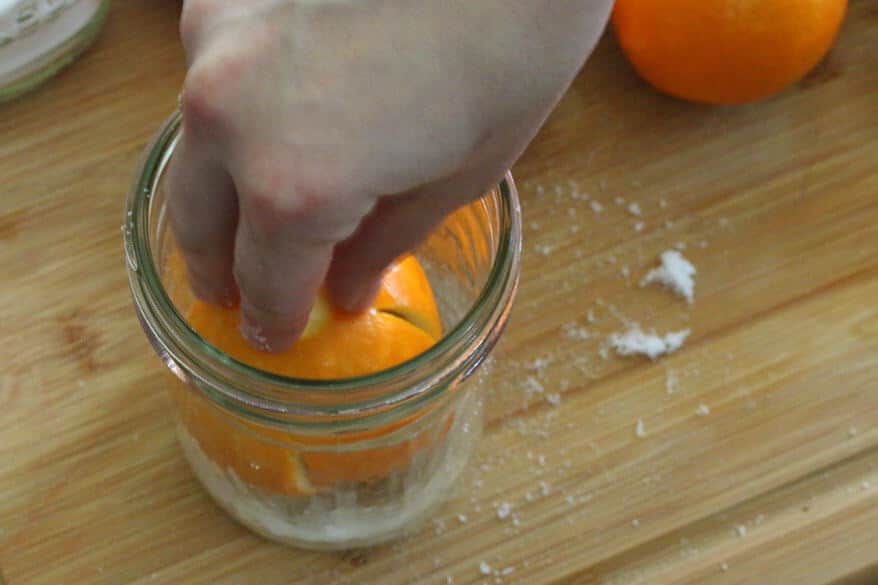
Put a teaspoon of salt over the top of the lemon.
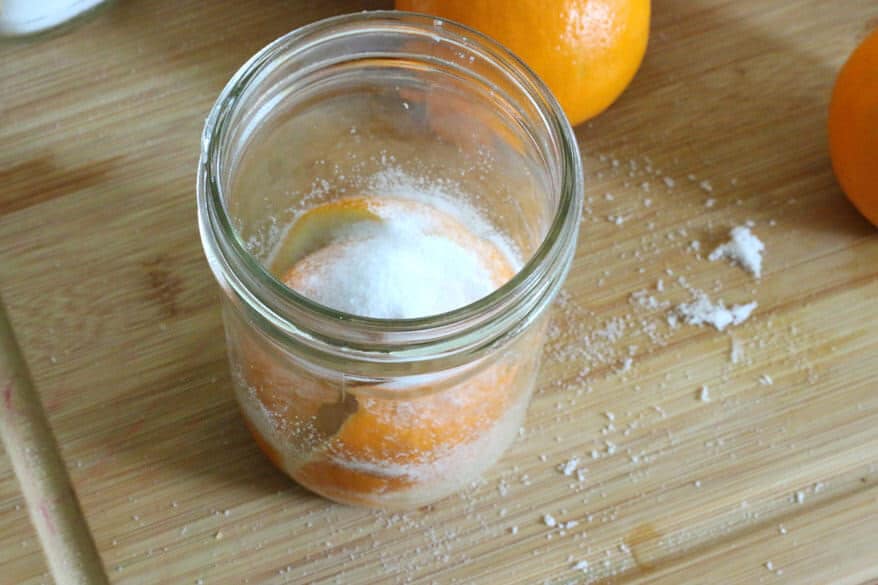
Repeat the process, putting a teaspoon of salt inside the second lemon, and then squish it down hard on top of the first lemon.
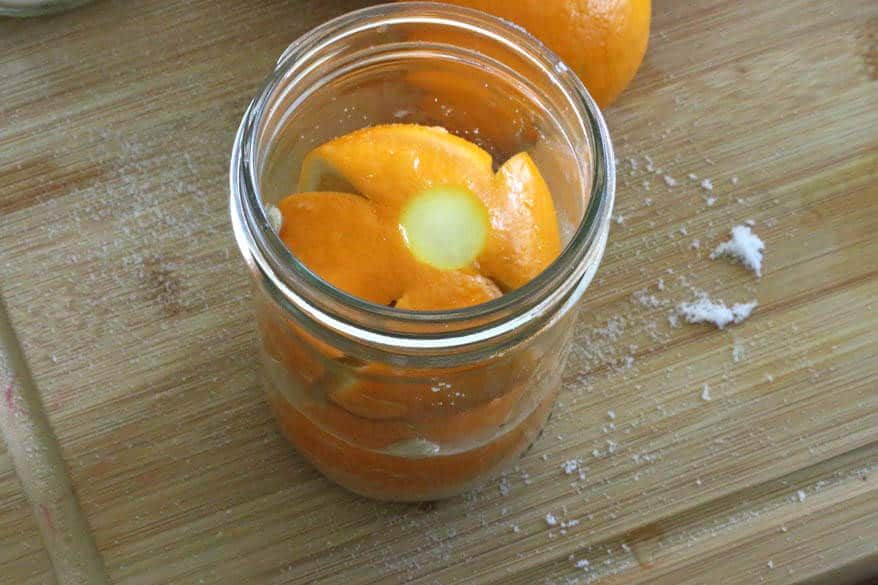
You got it – add another teaspoon of salt on top of the second lemon, and repeat the process for the third and final lemon. Add a teaspoon of salt on the very top. The jar should be at least halfway full of lemon juice from having compressed the lemons. If needed, squeeze some extra lemon juice into the jar to bring it to the halfway point. And don’t waste that lemon – cut it up and stuff it into the jar. Now pour some water that’s been boiled and cooled (sterile) into the jar to fill it up the rest of the way. Repeat this process for however many jars you wish to make.
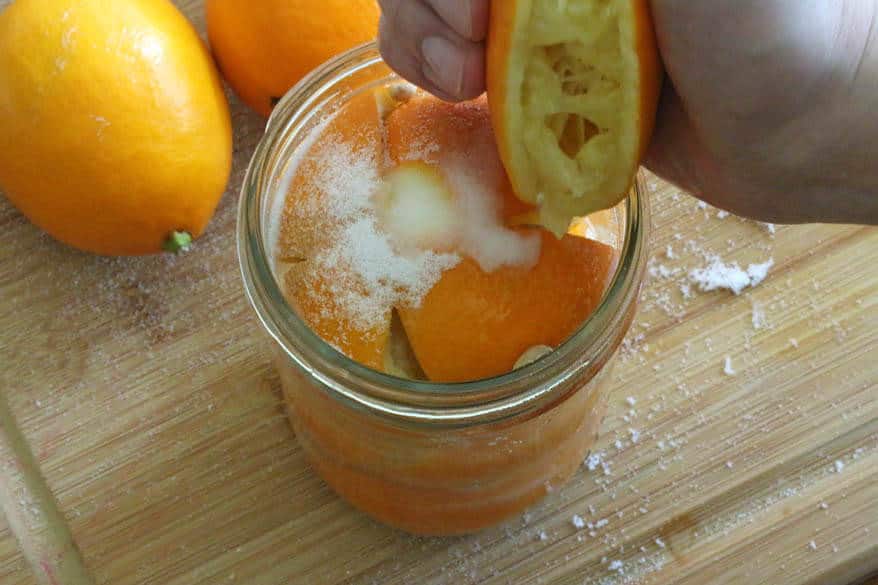
After you add the water, screw on the lid and let the jar sit at room temperature for 3 days, giving it a shake and turn it upside-down/right-side up a few times a day. After 3 days place the jar in the refrigerator and let it sit for at least 3 weeks before using. Keep the jar in the refrigerator. Whatever dish you use them in, discard the pulp (it’s the peel that is used) and thoroughly wash the peel to remove excess salt.
That’s it! Your preserved lemons are ready! *Taste bud choir breaks out into a stirring rendition of the “Hallelujah Chorus”*
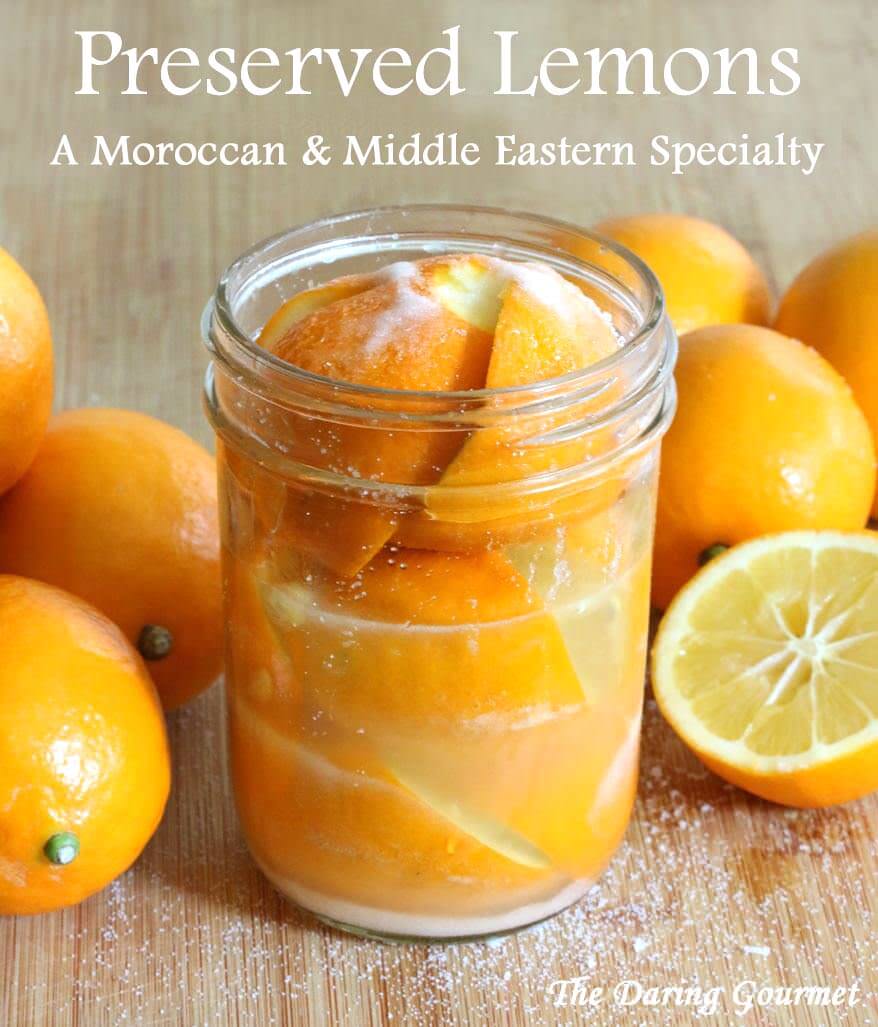
Save This Recipe

Preserved Lemons
Ingredients
- 3 Meyer lemons , or Eureka, Lisbon, etc, organic recommended per pint-sized jar
- 5-6 teaspoons sea salt or kosher salt (regular table salt contains iodine which will turn the lemons gray)
- An extra lemon for juicing
- Water that has been boiled and cooled sterile
Instructions
- Note: you can make however many preserved lemons you like, but roughly 3 will fit per pint-sized jar.Thoroughly clean the lemons. Organic is recommended. If you can't find organic, let the lemons sit in some vinegar water for a few minutes, then rinse.Trim the nubs off both ends of each lemon. Quarter each lemon, slicing them down just over 3/4 of the way to leave the slices attached at the end.Put one teaspoon of salt into the cavity of each lemon.Place one teaspoon salt into the bottom of the jar. Put a lemon in the jar, cut-side down, pressing firmly to squish out the lemon juice. Put a teaspoon of salt on top of the lemon. Firmly press the second lemon down on top of the first lemon. Repeat with the third lemon, pressing down firmly. Add a teaspoon of salt on top of the lemon.The jar should be at least halfway full with lemon juice. If needed, squeeze some additional lemon juice into the jar to bring it to the halfway point. Don't waste that lemon; slice it and stuff the slices into the jar. Pour the boiled/cooled water into the jar to fill it to the top.Screw the lid on and let it sit at room temperature for 3 days, shaking it and rotating the jar upside-down/right-side up a few times per day. After 3 days transfer the jars to the refrigerator and let them sit for at least 3 weeks before using. Stored in the fridge, they will keep for at least 6 months (see note).
Notes
* Whatever dish you use them in, discard the pulp (it’s the peel that is used) and thoroughly wash the peel to remove excess salt. * Using other citrus: You can also make preserved limes, oranges, grapefruit and kumquats! The process is identical but because high acidity is required for proper preservation you will still need to top off the jars with lemon juice.
Nutrition
Originally published on The Daring Gourmet April 8, 2014



















MMMmm These look great! Can you explain about what you meant by ‘topping off’ with lemon juice for preserving citrus fruits other than lemons? And should I measure acidity or estimate the acidity based on the sourness?
Hi Ann, it just means that if after you add the lemons and salt to the jar (or other citrus variety), if the citrus isn’t covered by the juices you’ll need to add some more lemon juice until they’re covered. Keeping the citrus submerged under liquid will prevent them from getting moldy.
my preserved lemons Has been sitting in my fridge for many months and has sludge in it now. what could’ve caused it and is it safe to use the lemons?
Hi Ruby, the pulp of the lemons will become slimy/sludgy over time, this is completely normal. That’s why most people when they use the lemons use only the peel, because the pulp is so sludgy. So just remove the lemons as needed, discard the pulp, give them a rinse, and use the peel.
Which brand of Kosher salt do you use for the amount specified in the recipe? Morton is far more “salty” by volume than Diamond Crystal.
Hi David, right now I’m using Diamond Crystal, before this batch I was using sea salt. For preserved lemons it really doesn’t matter, precise measurements aren’t important, because you’re going to be rinsing off the lemons before using anyway.
You can use the pulp if you want, and it has quite an interesting flavour. It contains a lot of salt, but you can substitute it for salt in recipes. Particularly good in stews, soups or dahls where you want to add a bit of tang.
DO YOU HAVE A SALT SUBSTITUTE ? , THAT MUCH SALT MAKES MY MOUTH FEEL DRY. ALSO PEOPLE WITH HIGH BLOOD PRESSURE CAN NOT USE THIS RECIPE. I LOVE LEMONS WITH WATER & CINNAMIN, GREAT FOR BLOOD SUGAR & BLOOD PRESSURE TOO. THANK YOU LAUREN
Hi Terry, the salt is the active preservative in making these preserved lemons in the same way that salt has been used in preserving meats and vegetables for thousands of years. Unfortunately there is no substitute. However, you’re not actually consuming the salt itself because you thoroughly rinse the lemons before using them.
It would have been nice in the directions/ingredients you mentioned not to use iodized salt. Gray lemons are gross. So now I just wasted 4 lemons. Might try again. It would just be nice to mention what iodized salt will do.
Hi Cindi, I do specify in the recipe to use sea salt or kosher salt but have added the additional note of why not to use table salt. Thanks.
Thank you for the recipe! Good to note also that some sea salts are iodized…..important to ready those labels!
I understand the recipe. I’m just not sure what part of the lemon you use. You put the whole lemons in the jar. When you use them do you scoop out the pulp and throw it away? Do you zest the lemon peel? Do you throw the whole lemon into the recipe? Please explain more about how they are used. Thanks!
Hi, you discard only the pulp and use the rest (ie, the yellow peel and white pith). Happy cooking!
Why does my preserved lemon turn black ?